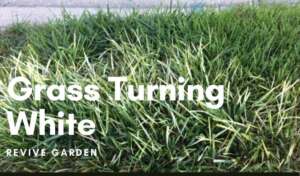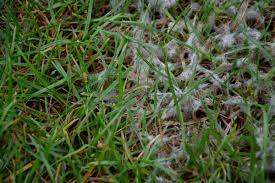Table of Contents
 Grass turning white is common in any garden, but it can be a bit of a mystery as to why it happens. Explore some of the most common causes of grass turning white and what you can do to save it from happening in the future. If you are noticing that your grass is turning white, there are a few things you can do to fix the problem. Grasses can experience many issues, such as excess moisture, diseases, or improper watering. If you detect one of these problems, take action to correct the issue.
Grass turning white is common in any garden, but it can be a bit of a mystery as to why it happens. Explore some of the most common causes of grass turning white and what you can do to save it from happening in the future. If you are noticing that your grass is turning white, there are a few things you can do to fix the problem. Grasses can experience many issues, such as excess moisture, diseases, or improper watering. If you detect one of these problems, take action to correct the issue.
In this article, we’ll provide tips on getting your lawn back to its normal colour and addressing the possible causes of white grass.
Grass Turning White- What are the Causes

You’re noticing that your grass is turning white – and it’s not just a springtime phenomenon. There are many possible causes of grass depending on white, and the most common ones are a result of stress, waterlogging, or a fungus. If you want to diagnose the root cause of the problem, you’ll need to take a closer look at the soil conditions and note any changes that might have occurred recently. If you decide that a fungus is present, treatment may involve using a fungicide or a grass drench. Grasses go through a gradual process of greying and dying, but a few things can cause this to happen more suddenly.
Symptoms
Symptoms of grass turning white include:
- The leaves on your grass will become light green, and the blades will begin to curl.
- The grass may also lose its green colour and turn a lighter shade of brown or yellow.
- Your lawn may appear dry and lifeless, even if you water it regularly.
Most common causes
Lack of nutrients
Lack of nutrients in the soil is a common factor. If your lawn is turning white because of a lack of nutrients, you can solve this problem by adding more organic matter to your soil. You may also want to consider fertilising your lawn regularly.
Hot weather
Another common reason for grass turning white is that it has been stressed by drought or excessive heat. If you have been experiencing drought conditions or frequent hot weather, try watering your lawn once a week is less, so twice a week is better, as this will help prolong the life of your lawn.
Insects
If you notice that your lawn has turned white and all other methods have been unsuccessful, it is due to an infestation of insects like fleas or white grubs (larvae). In this case, you will need professional assistance from an exterminator or licensed pest control company trained in dealing with infestations such as these.
Lack of phosphorus
If you have grass turning white, the most likely cause is a lack of phosphorus. Most lawns are deficient in phosphorus, but there are several ways to help your grass get the nutrients it needs. You can add lime or Epsom salts to the soil and apply fertiliser in the spring or fall. You can also buy an organic fertiliser that contains phosphorus.
Weather can be a big reason.
Cold weather
You live in a cool climate, where the average temperature is below 60 degrees Fahrenheit (15C). This will cause your grass to turn white.
Dry weather
You live in an area where it has been so dry that it has turned brown and died off, leaving only dead roots behind. This is super common during drought conditions and can happen any time of year, even if you don’t typically have a dry spell in your area.
Type of fertilizer
Your lawn has been treated with a type of fertiliser that contains nitrogen—a chemical that causes plants to grow faster than they normally would under normal conditions (which helps them stay green longer). Nitrogen levels in soils are naturally high near roads and parking lots because of all the traffic from cars driving over them; applying fertiliser containing nitrogen straight on top of this soil-rich environment can cause your grass to turn white.
Fungus attack
White-Grass Disease is caused by a fungus that grows in moist soil. The fungus attacks the roots of your grass—the microscopic filaments that hold the plant together and give it its strength. When this happens, there’s nothing left to support the plant as lightning strikes or heavy rains fall.
Remedies of white grass disease
There are a few things to avoid white grass disease.
Watering
Water your lawn daily (or at least twice a week) to moisten the soil.
Fungicide
Using a fungicide on affected areas of lawn once or twice per year (depending on whether you want to get rid of the problem or slow it down)
Fertilize
Another remedy is to fertilize the soil regularly to avoid white grass.
Best actions to take
When you notice white grass on your lawn, some actions must take immediately in addition to the remedies mentioned above.
professional lawn care service
When your grass turns white, it’s typically a sign that something is wrong. If you notice this happening on your lawn, you should first call a professional lawn care service. The best way to treat this issue is by using pesticides or herbicides to kill off the grass and prevent it from resprouting.
Temperature change
For the grass to turn white, there must be a temperature change in the soil or air around it. The temperature change causes the grass roots to expand and push through the soil, making it easier for sunlight to reach them and cause them to turn white. For example: If small cracks in your lawn allow sunlight into its root system, you will see patches of white on your lawn.
Conclusion
Grass turning white is a common problem that homeowners face every year. It’s caused by various factors like improper watering, high levels of salt in the soil, and frost damage. It can also be due to a fungus or bacteria that grows on the grass. There are various symptoms and remedies for grass turning white, so check out our article for more information.
Thanks for reading! This article talked about one of the homeowners’ most common concerns – the grass turning white. We hope by reading through the article, you’ll be able to understand the causes and symptoms of this problem and know what to do to solve it. We hope that you find this article helpful!
